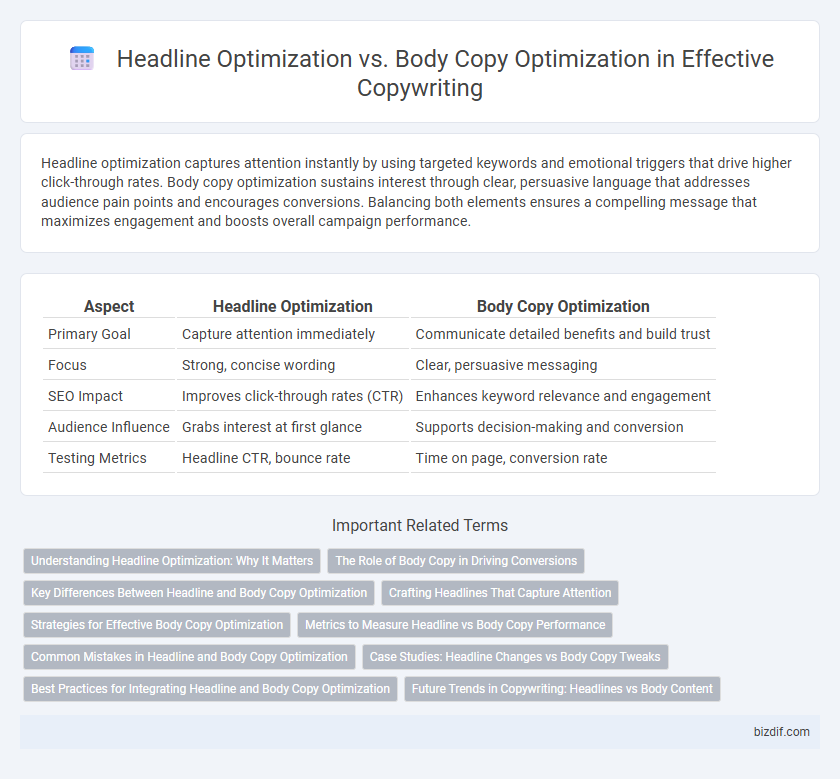Headline optimization captures attention instantly by using targeted keywords and emotional triggers that drive higher click-through rates. Body copy optimization sustains interest through clear, persuasive language that addresses audience pain points and encourages conversions. Balancing both elements ensures a compelling message that maximizes engagement and boosts overall campaign performance.
Table of Comparison
| Aspect | Headline Optimization | Body Copy Optimization |
|---|---|---|
| Primary Goal | Capture attention immediately | Communicate detailed benefits and build trust |
| Focus | Strong, concise wording | Clear, persuasive messaging |
| SEO Impact | Improves click-through rates (CTR) | Enhances keyword relevance and engagement |
| Audience Influence | Grabs interest at first glance | Supports decision-making and conversion |
| Testing Metrics | Headline CTR, bounce rate | Time on page, conversion rate |
Understanding Headline Optimization: Why It Matters
Headline optimization is crucial because it directly impacts click-through rates by capturing the audience's attention instantly. Effective headlines use targeted keywords and emotional triggers to improve search engine ranking and engage readers quickly. Prioritizing headline optimization increases visibility and drives higher traffic compared to relying solely on body copy improvements.
The Role of Body Copy in Driving Conversions
Body copy plays a crucial role in driving conversions by elaborating on the headline's promise and addressing potential customer objections with clear, persuasive language. Effective body copy provides detailed information, builds trust through benefits and social proof, and guides readers toward a call to action, increasing engagement and purchase intent. Optimizing body copy ensures the message resonates with the target audience, boosting conversion rates beyond the initial impact of headline optimization.
Key Differences Between Headline and Body Copy Optimization
Headline optimization focuses on capturing attention through concise, impactful language and keyword placement to boost click-through rates and search engine rankings. Body copy optimization emphasizes persuasive storytelling, clarity, and incorporating relevant keywords to improve reader engagement and conversion rates. Key differences lie in the headline's role as a brief attention-grabber versus the body copy's function to provide detailed, convincing information supporting the overall marketing goal.
Crafting Headlines That Capture Attention
Crafting headlines that capture attention is essential for maximizing click-through rates and engagement in copywriting. Headlines optimized with targeted keywords and emotional triggers significantly increase visibility and appeal to the audience's intent. Effective headline optimization drives traffic while body copy optimization ensures sustained reader interest and conversion.
Strategies for Effective Body Copy Optimization
Effective body copy optimization focuses on clarity, relevance, and engagement by incorporating targeted keywords naturally and addressing the audience's pain points. Utilizing persuasive language and clear calls-to-action enhances conversion rates, while maintaining readability ensures the message resonates with both users and search engines. Continuous testing and refining based on user behavior and feedback further strengthen the overall effectiveness of the body copy.
Metrics to Measure Headline vs Body Copy Performance
Headline optimization primarily focuses on metrics such as click-through rate (CTR) and bounce rate, which indicate how effectively the headline captures initial audience attention and drives traffic. Body copy optimization emphasizes conversion rate, time on page, and engagement metrics like scroll depth and heatmaps to measure how well the content sustains interest and persuades users to take action. Both headline and body copy performance analytics inform iterative testing strategies including A/B testing to maximize overall campaign effectiveness.
Common Mistakes in Headline and Body Copy Optimization
Common mistakes in headline optimization include using vague language that fails to capture attention and neglecting keyword relevance, which reduces search visibility. In body copy optimization, errors often involve poor readability due to long, complex sentences and insufficient use of persuasive calls to action that engage readers. Both headline and body copy errors can significantly decrease conversion rates and reduce overall content effectiveness.
Case Studies: Headline Changes vs Body Copy Tweaks
Case studies reveal that headline optimization frequently drives more immediate and measurable increases in click-through rates compared to body copy tweaks, highlighting the headline's critical role in capturing initial attention. Data from A/B testing shows headline changes can boost engagement by up to 30%, whereas body copy adjustments typically yield a more gradual improvement in conversion rates. Marketers prioritize headline experiments first to maximize impact before refining the body copy for sustained user interest and action.
Best Practices for Integrating Headline and Body Copy Optimization
Effective headline optimization captures attention with clear, benefit-driven language and relevant keywords, while body copy optimization sustains engagement through detailed, persuasive messaging that reinforces the headline's promise. Best practices involve ensuring headline and body copy alignment by maintaining consistent tone, addressing the same target audience, and using complementary calls to action to drive conversions. Utilizing A/B testing for both headline variations and body copy refinements maximizes impact by identifying the most compelling combination for click-through and conversion rates.
Future Trends in Copywriting: Headlines vs Body Content
Future trends in copywriting emphasize the growing importance of AI-driven headline optimization to capture attention instantly, while body copy optimization increasingly relies on personalized, data-driven content to engage readers deeply. Advanced analytics and machine learning tools enable precise A/B testing and real-time adjustments for both headlines and body content, maximizing conversion rates. Integrating semantic SEO strategies into headline and body copy will enhance search engine visibility and user experience, shaping the next evolution in digital marketing effectiveness.
Headline Optimization vs Body Copy Optimization Infographic

 bizdif.com
bizdif.com